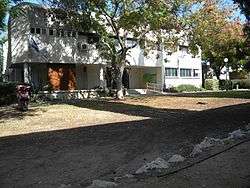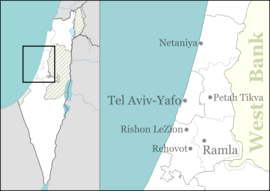Aseret
Aseret (Hebrew: עֲשֶׂרֶת) is a community settlement on the coastal plain of south-central Israel. Located near Gedera, it falls under the jurisdiction of Gederot Regional Council. The word "Aseret" means ten, and the community is named after the ten members of Bilu who founded Gedera.[2] In 2019 its population was 1,012.[1]
Aseret עֲשֶׂרֶת | |
|---|---|
 | |
 Aseret  Aseret | |
| Coordinates: 31°49′28.56″N 34°44′48.83″E | |
| Country | |
| District | Central |
| Council | Gederot |
| Region | Shephelah |
| Founded | 1954 |
| Population (2019)[1] | 1,012 |
| Name meaning | Ten (after ten members of Bilu) |
History
Aseret was founded in 1954 as the municipal center of Gederot Regional Council. It continues to serve this function today. Aseret is the center, both geographically and municipally, of the other six communities in the council: Meishar, Misgav Dov, Kfar Aviv, Kfar Mordechai, Shdema and Gan HaDarom.[2]
Aseret was built on the lands of Bashshit, a Palestinian village depopulated in the 1948 Arab–Israeli War.[3] There is an old tomb associated with Seth, the son of Adam in the Hebrew Bible.[2] According to scholars of the Palestine Exploration Fund, the name Bashshit was derived from Beit Shit, meaning the "house of Seth.[4][5] The tomb lies within a triple-domed mosque located on the side of a hill.[6]
References
| Wikimedia Commons has media related to Aseret. |
- "Population in the Localities 2019" (XLS). Israel Central Bureau of Statistics. Retrieved 16 August 2020.
- Mapa's concise gazetteer of Israel (in Hebrew). Yuval El'azari (ed.). Tel-Aviv: Mapa Publishing. 2005. p. 437. ISBN 965-7184-34-7.CS1 maint: others (link)
- Khalidi, Walid (1992). All That Remains: The Palestinian Villages Occupied and Depopulated by Israel in 1948. Washington D.C.: Institute for Palestine Studies. p. 363. ISBN 0-88728-224-5.
- Palestine Exploration Fund (PEF), 1838, p. 84.
- Palestine Exploration Fund. "Quarterly Statement for 1877". Internet Archive. Retrieved 2009-08-22.
- Petersen, Andrew (2002). A Gazetteer of Buildings in Muslim Palestine: Volume I (British Academy Monographs in Archaeology). Oxford University Press. ISBN 978-0-19-727011-0.